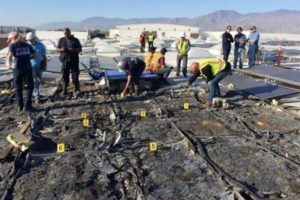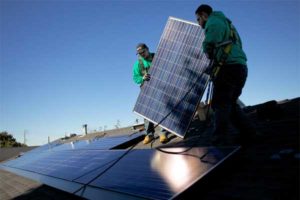Some homeowners and corporations claim a faulty product used with Tesla solar panel systems causes the panels to spontaneously combust.
These homeowners said they are frustrated as they wait for Tesla to fix damaged panels on their roofs.
On the other hand, Corporations like Walmart, are filing lawsuits against Tesla for rooftop fires they claim are caused by Tesla solar systems. Adding that the issue starts with a product included in the systems installed.
These allegations are very disturbing considering that the Wallingford, Connecticut-based manufacturer of the said product, denies the claims.
On August 1, the roof of Briana Greer’s home in Colorado caught fire as she waited for Tesla to send a crew to look at her panels. Greer said that the issue stems from the fact that Tesla didn’t properly maintain the panels.
Other homeowners in states from Maryland to Arizona with Tesla solar panels have also found dealing with the company on this issue to be frustrating. Many say they’ve been forced to pay regular fees as their systems have been shut off.

An inspection team works on the roof of a Walmart store in Indio, Calif., after a fire in 2018 (Walmart/New York State Supreme Court)
On the corporate angle, Walmart recently filed a lawsuit against Tesla.
The lawsuit claims Tesla’s installed solar panels caused fires on seven of its store rooftops between 2012 and 2018, leading to millions of dollars in damages.
Amazon also stepped forward to claim that it has had issues with fires caused by the same solar panels installed by Tesla.
Saying that Tesla’s SolarCity division installed solar panels burst into flames on the roof of one of their warehouses in Redlands, California.
The incident at the Amazon facility reportedly happened back in June 2018, but the e-commerce giant only recently came out with the information.
Walmart on its part did some investigations and found out that Tesla had installed a faulty product with the systems.
The products in question are Amphenol connectors that fail to regulate heat going into the solar panels. As a result, they say, the panels experienced temperature spikes that led to fires.
Amphenol Corp., the maker of these said electrical connectors, fired back by rejecting “any suggestion that its products caused the solar-equipment fires on store roofs” as stated in this specific Walmart case.
The company added that they “have no reason to believe that Amphenol’s products are the cause of any issues related to the claims filed by Walmart against Tesla.”
Fortunately, Tesla had already launched a program called “Project Titan,” to remedy the situation.
The program primarily focused on connectors made by Amphenol and optimizers, which regulate the amount of energy and heat that flows to a solar panel.
The program involves identifying, making repairs and changes on solar panel systems across the United States.
But the question remains: “are the Amphenol connectors to blame here?”
Walmart said in its complaint that Tesla never provided sufficient “root cause” analysis of why these fires happened. Project Titan’s existence answers some of those questions.
To execute Project Titan, Tesla ordered supplies including ladders and tool belts and sent crews out around the United States, according to the former employee.
The replacement parts had to be ordered as well, as all of the Amphenol H4 connectors were to be replaced with MC4 connectors.














Comments